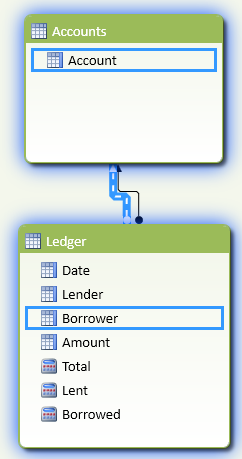didijaba
Well-known Member
- Joined
- Nov 26, 2006
- Messages
- 511
Hello, I would like to show cash flow for lending and borrowing (landing as + and borrowing as -) using Power Pivot and DAX. First table is what I have, and second is what I want. Do you have any ideas how to do this?
<style type="text/css">
table.tableizer-table {
border: 1px solid #CCC; font-family: Arial, Helvetica, sans-serif
font-size: 12px;
}
.tableizer-table td {
padding: 4px;
margin: 3px;
border: 1px solid #ccc;
}
.tableizer-table th {
background-color: #104E8B;
color: #FFF;
font-weight: bold;
}
</style><table class="tableizer-table">
<tr class="tableizer-firstrow"><th>Date</th><th>Lender</th><th>Borrower</th><th>Amount</th></tr>
<tr><td>15.1.2014</td><td>AAA</td><td>BBB</td><td>100</td></tr>
<tr><td>30.1.2014</td><td>AAA</td><td>CCC</td><td>200</td></tr>
<tr><td>14.2.2014</td><td>BBB</td><td>AAA</td><td>300</td></tr>
<tr><td>1.3.2014</td><td>BBB</td><td>CCC</td><td>400</td></tr>
<tr><td>16.3.2014</td><td>CCC</td><td>AAA</td><td>500</td></tr>
<tr><td>31.3.2014</td><td>CCC</td><td>BBB</td><td>600</td></tr>
<tr><td>15.4.2014</td><td>DDD</td><td>AAA</td><td>700</td></tr>
<tr><td>30.4.2014</td><td>DDD</td><td>BBB</td><td>800</td></tr>
</table>
<style type="text/css">
table.tableizer-table {
border: 1px solid #CCC; font-family: Arial, Helvetica, sans-serif
font-size: 12px;
}
.tableizer-table td {
padding: 4px;
margin: 3px;
border: 1px solid #ccc;
}
.tableizer-table th {
background-color: #104E8B;
color: #FFF;
font-weight: bold;
}
</style><table class="tableizer-table">
<tr class="tableizer-firstrow"><th>Cash flow report</th><th> </th></tr>
<tr><td> </td><td> </td></tr>
<tr><td>Row Labels</td><td>Cash flow</td></tr>
<tr><td>AAA</td><td>-1200</td></tr>
<tr><td>15.1.2014</td><td>100</td></tr>
<tr><td>30.1.2014</td><td>200</td></tr>
<tr><td>14.2.2014</td><td>-300</td></tr>
<tr><td>16.3.2014</td><td>-500</td></tr>
<tr><td>15.4.2014</td><td>-700</td></tr>
<tr><td>BBB</td><td>-800</td></tr>
<tr><td>15.1.2014</td><td>-100</td></tr>
<tr><td>14.2.2014</td><td>300</td></tr>
<tr><td>1.3.2014</td><td>400</td></tr>
<tr><td>31.3.2014</td><td>-600</td></tr>
<tr><td>30.4.2014</td><td>-800</td></tr>
<tr><td>CCC</td><td>500</td></tr>
<tr><td>30.1.2014</td><td>-200</td></tr>
<tr><td>1.3.2014</td><td>-400</td></tr>
<tr><td>16.3.2014</td><td>500</td></tr>
<tr><td>31.3.2014</td><td>600</td></tr>
<tr><td>DDD</td><td>1500</td></tr>
<tr><td>15.4.2014</td><td>700</td></tr>
<tr><td>30.4.2014</td><td>800</td></tr>
<tr><td>EEE</td><td>0</td></tr>
<tr><td>Grand Total</td><td>0</td></tr>
</table>
<style type="text/css">
table.tableizer-table {
border: 1px solid #CCC; font-family: Arial, Helvetica, sans-serif
font-size: 12px;
}
.tableizer-table td {
padding: 4px;
margin: 3px;
border: 1px solid #ccc;
}
.tableizer-table th {
background-color: #104E8B;
color: #FFF;
font-weight: bold;
}
</style><table class="tableizer-table">
<tr class="tableizer-firstrow"><th>Date</th><th>Lender</th><th>Borrower</th><th>Amount</th></tr>
<tr><td>15.1.2014</td><td>AAA</td><td>BBB</td><td>100</td></tr>
<tr><td>30.1.2014</td><td>AAA</td><td>CCC</td><td>200</td></tr>
<tr><td>14.2.2014</td><td>BBB</td><td>AAA</td><td>300</td></tr>
<tr><td>1.3.2014</td><td>BBB</td><td>CCC</td><td>400</td></tr>
<tr><td>16.3.2014</td><td>CCC</td><td>AAA</td><td>500</td></tr>
<tr><td>31.3.2014</td><td>CCC</td><td>BBB</td><td>600</td></tr>
<tr><td>15.4.2014</td><td>DDD</td><td>AAA</td><td>700</td></tr>
<tr><td>30.4.2014</td><td>DDD</td><td>BBB</td><td>800</td></tr>
</table>
<style type="text/css">
table.tableizer-table {
border: 1px solid #CCC; font-family: Arial, Helvetica, sans-serif
font-size: 12px;
}
.tableizer-table td {
padding: 4px;
margin: 3px;
border: 1px solid #ccc;
}
.tableizer-table th {
background-color: #104E8B;
color: #FFF;
font-weight: bold;
}
</style><table class="tableizer-table">
<tr class="tableizer-firstrow"><th>Cash flow report</th><th> </th></tr>
<tr><td> </td><td> </td></tr>
<tr><td>Row Labels</td><td>Cash flow</td></tr>
<tr><td>AAA</td><td>-1200</td></tr>
<tr><td>15.1.2014</td><td>100</td></tr>
<tr><td>30.1.2014</td><td>200</td></tr>
<tr><td>14.2.2014</td><td>-300</td></tr>
<tr><td>16.3.2014</td><td>-500</td></tr>
<tr><td>15.4.2014</td><td>-700</td></tr>
<tr><td>BBB</td><td>-800</td></tr>
<tr><td>15.1.2014</td><td>-100</td></tr>
<tr><td>14.2.2014</td><td>300</td></tr>
<tr><td>1.3.2014</td><td>400</td></tr>
<tr><td>31.3.2014</td><td>-600</td></tr>
<tr><td>30.4.2014</td><td>-800</td></tr>
<tr><td>CCC</td><td>500</td></tr>
<tr><td>30.1.2014</td><td>-200</td></tr>
<tr><td>1.3.2014</td><td>-400</td></tr>
<tr><td>16.3.2014</td><td>500</td></tr>
<tr><td>31.3.2014</td><td>600</td></tr>
<tr><td>DDD</td><td>1500</td></tr>
<tr><td>15.4.2014</td><td>700</td></tr>
<tr><td>30.4.2014</td><td>800</td></tr>
<tr><td>EEE</td><td>0</td></tr>
<tr><td>Grand Total</td><td>0</td></tr>
</table>






